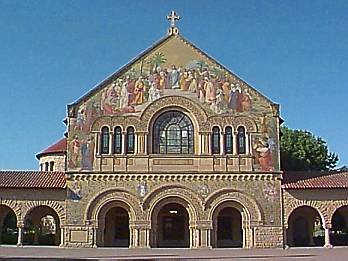 |
|

The church: Leland Stanford Memorial Church, Stanford University, Palo Alto, California.
Denomination: Non-denominational.
The building: It would be best to describe this chapel as a mixture of styles. The basic structure is Romanesque, covered with mosaics of biblical scenes on the outside. Inside, the Arts and Crafts Movement architecture is brightened by touches of Islamic, Baroque and Byzantine architectural flourishes. The interior walls are covered with mosaics. They have the gold background of pre-Renaissance International Gothic paintings, yet the figures have the painterly quality of Rococo or Pre-Raphaelite paintings. The total effect is sumptuous, awe inspiring. The gold tiles on the mosaics sparkled in the light, surrounding you with an unearthly glow. The church is mostly a tourist attraction by day, however various chaplaincies at the school hold services there, and there is a non-denominational service each Sunday. As you walk into the courtyard of the church, there are full-size bronze reproductions of Rodin's "Burghars of Calais" – magnificent sculptures which are the artistic epitomy of self-sacrifice for the good of one's community.
The neighbourhood: Stanford University is one of the most prestigious schools in the United States. It's where the elite meet, as they say. The school and chapel were built in the late 1890s by the Stanfords, multi-millionaires who struck it rich in railroads after the California Gold Rush. Surrounded by rolling, undeveloped hills, the school is separated from the urban sprawl that surrounds it as if it were an island.
The cast: The celebrants were Rev. Penelope Duckworth, Episcopal Chaplain, and Rev. Richard Foster, Lutheran Campus Pastor. The magnificent choir was visiting from St Mark's Episcopal Church in Berkeley.
Choral Evensong and Concert on the Feast of St Nicholas of Myra.
How full was the building?
About 100-150 people. We were dwarfed in a church that could easily seat 1,000 or more.
Did anyone welcome you personally?
No.
Was your pew comfortable?
No, standard wood pews, could have used cushions.
How would you describe the pre-service atmosphere?
Slight whispering among people in attendance. Most of us were gaping at the gorgeous interior of the building.
What were the exact opening words of the service?
After the organ voluntary and the opening hymn, the service began: "O Lord, open thou our lips." "And our mouth shall show forth thy praise."
What books did the congregation use during the service?
Service booklet, drawn from Rite I from the Episcopal Book of Common Prayer as well as the Church of England Book of Common Prayer. Hymns were reprinted from the 1982 Episcopal Hymnal. It has been a long time since I've experienced a service with all the thees, thines, and "Holy Ghost" rather than "Holy Spirit". The traditional language fit the music, however.
What musical instruments were played?
Two organs. One, a Fisk with 4,422 pipes, the other a Harris with 57 stops and 3,702 pipes. They definitely take music very seriously here.
Did anything distract you?
The microphone on the pulpit for the homily was not working. We couldn't understand a word she said.
Was the worship stiff-upper-lip, happy clappy, or what?
It was dignified, stately, very impersonal. Given the massive size of the church, there was no eye contact between the priests, the choir or the people in the congregation – we were too far away.
Exactly how long was the sermon?
12 minutes.
On a scale of 1-10, how good was the preacher?
I can't even rate her, I couldn't hear what she said.
In a nutshell, what was the sermon about?
I have no idea. My friend thought that she was talking about the history of St Nicholas of Myra, but he wasn't sure.
Which part of the service was like being in heaven?
Except for the technical glitch that ruined the homily, the rest of the service was heaven. A 40-member choir, operatic soloists and a world-class organist filling the cavernous golden church with sublime music... it was heaven all the way through.
And which part was like being in... er... the other place?
None – even with the microphone problem, there was so much to look at, it was really no problem.
What happened when you hung around after the service looking lost?
A choral concert immediately followed the evensong service, so we filed out after the concert. The priest was standing in the foyer and greeted us as we left – thanked us for coming.
How would you describe the after-service coffee?
There were no refreshments afterwards.
How would you feel about making this church your regular (where 10 = ecstatic, 0 = terminal)?
This wasn't an experience for the community aspect or the theology, yet this was a 10 for me, because it was an exquisite sensory delight. Sadly, I don't live close by, so I will only be able to return sporadically.
Did the service make you feel glad to be a Christian?
More than that... glad to be human, glad to be alive.
What one thing will you remember about all this in seven days' time?
I was literally moved to tears by the opening hymn, "Hark! A thrilling voice is sounding," and by Byrd's "Ave verum corpus" that was performed later in the concert. But most of all, I'll remember the glow of the gold mosaics.
| The Mystery Worshipper is sponsored by surefish.co.uk, the internet service provider from Christian Aid. By offering email services, special offers with companies such as amazon.co.uk and smile.co.uk, surefish raises more than £300,000 a year for Christian Aid's work around the world. Click here to find out how to become a Mystery Worshipper. And click here if you would like to reproduce this report in your church magazine or website. Top | Other Reports | Become a Mystery Worshipper! © Ship of Fools 2001 |